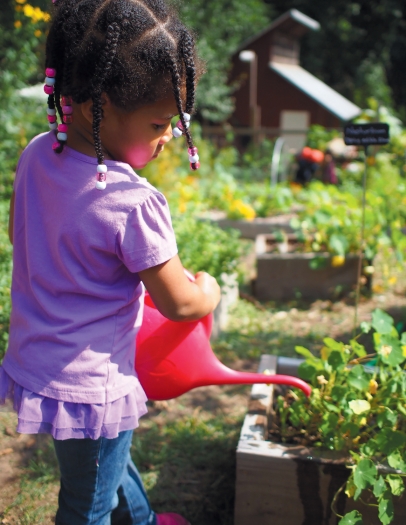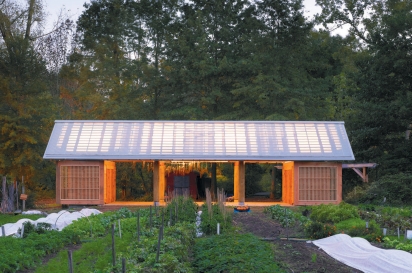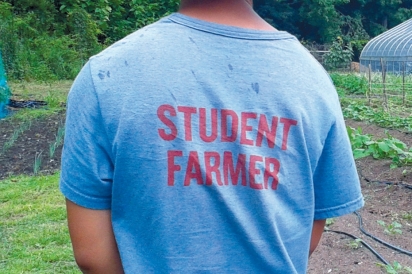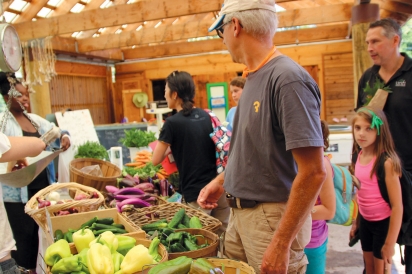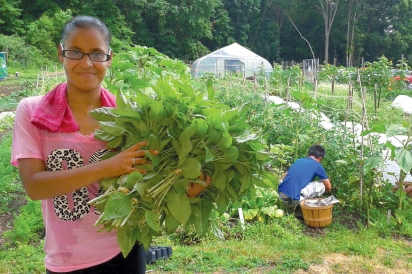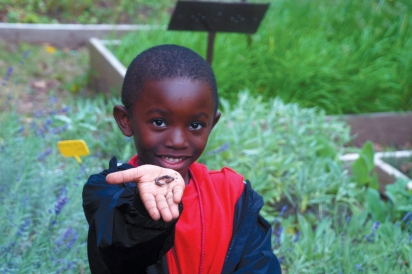Common Ground Empowers High School Students to Lead Healthy Lives
Most of us probably share roughly similar memories of our high school experience, in which we likely spent much of our time sitting at a desk, waiting for a bell to indicate the moment at which we should move to a new desk. But if you were to attend Common Ground in New Haven, your experience would assuredly be different.
But then, Common Ground is no ordinary high school. It is a high school with a farm in a forest in a city. This unique organization has an ambitious mission: to grow environmental leaders. Common Ground accomplishes this by empowering students to take the initiative in their community to create and maintain a clean environment; to inspire them to be advocates of healthy living who supply fresh food to citizens; and to continue to educate themselves and their community beyond their time in school.
Sitting on 20 acres of city park land in New Haven, Ground is part high school, part urban farm, and part environmental Common leducation center. Formed as a non-profit in 1991, Common Ground launched as a charter high school in 1997, the first with an ecology-based mission in Connecticut. The school’s 185 students come from 16 surrounding districts and represent every neighborhood in New Haven. The school views the farm, the forest, and the city as three laboratories for education and learning.
The campus’ three-quarter acre urban farm is a year-round operation and generated 10,800 pounds of produce in 2015. But its function as a classroom is something that separates this high school from others. A portion of the curriculum at Common Ground is structured around the farm, along with the 1,800 acres of West Rock Ridge State Park, which surround the school. Every subject has some aspect of the farm and environmental study built into it. “We connect what’s going on in the classroom with something applicable that is happening on the farm, and then we work on the farm,” says Shannon Raider-Ginsburg, the Farm Manager and Director of Agricultural Programs.
In Spanish class, students study vocabulary directly related to farming. Science classes test soil and monitor local parks for bird and insect biodiversity. Math classes present challenging problems, such as figuring out how much garlic can be produced given a certain amount of growing space or creating an entire business model based on the cost of a single Common Ground egg. “The goal of the high school is to give our students as much practical, authentic, and challenging work as they can do. We’re focused on preparing our students for college and environmental leadership,” says Joel Tolman, Director of Impact and Engagement. And it seems to be working; in each of the last five years, at least 90% of Common Ground students were accepted to college.
The task of preparing students for environmental leadership begins at freshman orientation – which is an overnight campout full of team-building exercises – and it continues through graduation. During their time at Common Ground, students create portfolios compiling all the ways in which they feel they’ve grown as leaders. The portfolios accumulate reflections, artifacts, and experiences that have defined each student, as well as their personal beliefs regarding what it means to steward the local environment. Upon completion of the portfolio, Tolman explains that students “have to stand up and defend them in front of a panel of adults. And they can’t graduate unless they successfully defend their portfolios.”
And Common Ground has no shortage of opportunities for students to develop experiences for their portfolios. Students are encouraged to work, volunteer, and get involved outside of the classroom, and the school offers multiple opportunities for them to do so. The Green Jobs Corps, afterschool programs, the farm, and the Mobile Market all offer students the chance to work and to help their community. One such opportunity is the Urban Refuge Initiative in New Haven. As Joel Tolman explains, “The goal is to restore habitat on city park land, neighborhood green spaces, and school grounds to create better habitat for wildlife, but also be a real health-giving resource for people.”
“It’s all about developing a sense of wonder and curiosity,” Raider-Ginsburg says. She teaches students about sustainable farming, including techniques that protect the environment and promote public health and animal welfare. Under her guidance, students get to experience where their food comes from. “The idea is to empower people and our students by connecting them to the work on the farm,” she says. They learn about the history of farming, where plants originated, ownership of land and its relationship to food, what we grow and eat in Connecticut, and the social history of farming. “Everything that goes into an agricultural season – from putting a seed in the greenhouse to selling a tomato at the farm stand – crosses every lesson.”
Each year, some 3,000 seedlings are planted. Aside from growing fruits and vegetables, Common Ground also has pigs, turkeys, chickens, goats, and sheep. “We raise animals for meat...to bring people closer to the experience of where their food comes from,” says Raider-Ginsburg. They teach students and volunteers humane animal husbandry as well as proper farm terminology. They don’t “kill” animals for food; the animals are “processed.” When asked if processing chick- ens for food bothered him, sophomore Victor Vega shook his head and explained that, when it comes to feeding people, “You gotta do what you gotta do.”
The food they produce goes to the Common Ground farm stand, open one day per week during the summer, as well as a Mobile Market that delivers food to senior centers, public housing projects, and neighborhoods without easy access to grocery stores. Some of the surplus food is marketed to local restaurants in the summer, and all students and faculty eat Common Ground-grown and-produced food for free.
Since the school opened, students have been given opportunities to build parts of the campus with their own hands. They built the small building that houses the goats and sheep as well as a walking bridge. They also designed an interpretative exhibit and planted a peace pole. “We want to give students not just authentic learning opportunities, where they’re having to put skills into work, but also opportunities that will allow them to grow as leaders,” Tolman says. Some years back, students found an old map of nature trails that ran through the park that surrounds the school. With the help of teachers, they went in and restored many of the trails that can now be enjoyed by students and visitors alike.
Environmental education and learning on the farm extends beyond Common Ground students. Last year, approximately 5,000 elementary students from New Haven came through on field trips and enjoyed lessons at The Children’s Garden, a growing plot located on the campus that is specifically designed for teaching and learning. Students learn about various aspects of nature, about soil, composting, and most importantly, are shown where their food comes from. What they learn on these field trips is directly tied to the curriculum at theirschools. There are also opportunities for home-schooled students to come and learn at The Children’s Garden.
Melissa Spear, Executive Director of Common Ground, hopes to reach students from other schools and to inspire them to build gar- dens of their own. Common Ground has developed a program to help interested schools install similar gardens as well as help them develop the classroom and afterschool programming that goes along with it. “We’re trying to create this network to support school gardens throughout the state of Connecticut,” says Spear. More information about this program is available at the CT School Garden Resource Center.
Teachers are known for being enthusiastic and dedicated to their students, and this is particularly true for the faculty and their pro- grams at Common Ground. Perhaps this is borne out of the challenge of running a high school that does not merely prepare students for college, but also champions healthy and environmentally sustainable ways of thinking and living, and that is dedicated to developing lead- ers who will carry on this mission in their own way, whatever their career path. The heart of this idea lies embedded in the school’s name, as each student learns about the primacy of their shared “common ground” and finds his or her own way to make the best use of it. As Connecticut’s small communities increasingly look inward for self- reliance and sustainability, it is good to know that a school like Com- mon Ground is readying our youngest citizens not only to put their hands in the dirt, but also to lead others who are willing to do so.
The Common Ground campus is open to the public every Saturday from 10am-2pm, April through November, for Open Farm Days.
> Common Ground: 358 Springside Ave., New Haven; 203-389-4333; commongroundct.org
> CT School Garden Resource Center: ctschoolgardens.org


